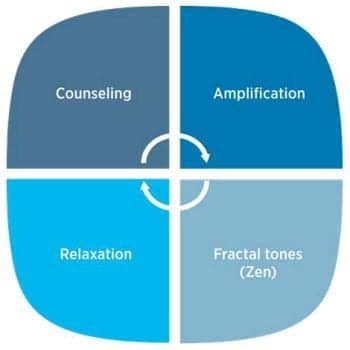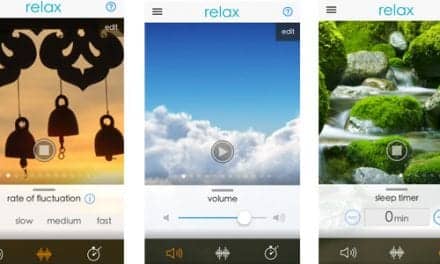Widex Zen Therapy (WZT) combines the use of counseling, amplification, fractal tones, relaxation strategies, sleep management, and many elements associated with Tinnitus Retraining Therapy (TRT) and Cognitive Behavioral Therapy (CBT) for an individualized comprehensive tinnitus management program.
The distress associated with tinnitus has complex roots that are characterized by a diverse activation of neural structures. The components comprising tinnitus distress include the phantom auditory perception, the hyper-vigilance and excessive attention paid to the tinnitus, and the negative emotional element. In addition, major issues contributing to the anguish experienced by tinnitus patients include hearing loss, sleep deprivation, maladaptive thoughts and behaviors, and excessive stress.

Robert W. Sweetow, PhD, is a professor in the Dept of Otolaryngology at the University of California, San Francisco and was Director of Audiology at the UCSF Medical Center Audiology Clinic for 20 years (1991-2011). He also serves as a parttime consultant for Widex A/S. Anne Mette Kragh Jeppesen, MA, is an audiologist at the Audiological Research Dept at Widex A/S, Lynge, Denmark. Correspondence can be addressed to Dr Sweetow at:
Dozens of counseling and sound therapies have been proposed over the past two decades. While each of these approaches has been reported to be beneficial for certain patients, none are universally effective, and only a few have survived the test of time. Furthermore, none of the existing tinnitus therapies directly address all of the problems listed above that contribute to the distress experienced by tinnitus patients. Inattention to any of these issues can lead to failure.
In this paper, we describe a new integrated approach to tinnitus patient management that incorporates not only the optimal segments of existing therapies, but novel acoustical stimuli and relaxation exercises, as well. The overall objective of Widex Zen Therapy (WZT) is to ensure that the tinnitus does not negatively impact the patient’s quality of life. It does not purport to be a cure, or to suppress tinnitus. The four main components of WZT, as shown in Figure 1, are:
- Counseling. This is both instructional and adjustment based,to educate the patient and assist the limbic system to alter or reclassify the negative interpretation of the tinnitus. For patients with high tinnitus distress levels, the use of Cognitive Behavioral Intervention (CBI) is recommended.
- Amplification. This stimulates the ears and brain in order to minimize increases in central activity (overcompensation) and maladaptive cortical reorganization.
- Fractal tones. A novel, proven acoustic stimulus—filtered in accordance with the hearing loss and delivered dichotically in a discreet, inconspicuous, and convenient manner—designed to both relax and provide acoustic stimulation.
- Relaxation strategy program. Highlighted by behavioral exercises and sleep management.
The general rationale for inclusion of these elements is based on the following beliefs:

Figure 1. Main elements of WZT.
- Counseling contributes greatly to the reduction of distress related to tinnitus and to the facilitation of habituation.
- The most popular counseling approaches are those incorporated into Tinnitus Retraining Therapy (TRT)1 and Cognitive-Behavioral Therapy (CBT).2,3 Critics of these approaches have argued that they are too restrictive.4 TRT focuses on helping the patient reclassify tinnitus as a non-salient stimulus to emphasize the brain’s natural ability to habituate. A different focus is used in CBT, which teaches the patient coping strategies, distraction techniques, and methods of identifying and correcting maladaptive thoughts and behaviors. Combining the two approaches, however, has the advantage of addressing all three primary aspects of tinnitus distress (auditory, attentional, and emotional).
- While it is possible for tinnitus to occur in the absence of a measurable hearing loss, the vast majority of individuals with chronic tinnitus show at least some degree of hearing deficit.5 It is believed that, when a peripheral hearing deficit exists, a cascade of reorganizational and physical changes occurs, leading to increased neural activity in the central auditory pathways.6,7
Specifically, the central nervous system reacts to the lack of appropriate neural stimulation from the ear by increasing its “attentiveness” to the auditory signals that do reach it, with consequent awareness of sounds arising from previously subconscious abnormal neural activity in the system. One of the reasons hearing aids have been successfully used to provide a certain degree of relief from tinnitus8-11 is that they provide increased neural stimulation, which in turn may decrease the central auditory system’s need to “overcompensate” for the peripheral attenuation. - It has been demonstrated that sound enrichment can prevent maladaptive cortical tonotopic reorganization following noise exposure.12
- Existing sound therapies, while helpful, have limitations. Masking might provide a degree of immediate relief, but in the long term may be perceived as being little more than the substitution of one annoying sound for another. Perhaps even more important is the belief that masking is counterproductive to habituation, because in order for habituation to occur, the person must be repeatedly exposed to that stimulus.13
The concept of masking thus has largely been replaced by the use of low-level broadband noise. But these steady-state signals may not foster stress reduction and relaxation, and, like masking, do not address the long-term emotional issues related to tinnitus. Also, some sound therapies require headphones, and thus may be intrusive, uncomfortable, or impractical for use during the work day. Other therapies employ a limited number of pre-recorded stimuli that can become predictable or boring, or promote active, rather than passive, listening. Furthermore, unless the sound therapy provides a correction for any existing hearing loss, the increase in central auditory gain is not being addressed. - Stress is one of the most significant exacerbating factors for tinnitus.14
- A recent investigation15 concluded that, while noise exposure and stress were both important contributors to tinnitus, stress was the more important factor for the transition from mild to severe distress.
- It has been reported that listening to music can result in physiological changes correlated with relaxation and stress relief.16 Patterns of musical elements, such as slower tempo, lower pitch, some degree of repetition, and lack of emotional content, have been established as having a calming, rather than alerting, effect.17,18 However, other articles have suggested that music can be less effective if it creates cognitive stimulation or has a negative emotional attachment.19,20
- A recent survey21 indicated that, of nine tinnitus treatment methods assessed (hearing aids, music, medication, relaxation exercises, counseling, non-wearable sound generators, herbs and dietary supplements, wearable sound generators, and psychological counseling), the most substantial tinnitus amelioration was achieved with hearing aids (34%), followed closely by the use of music (30%). No other single treatment achieved an efficacy of more than 10%.
- More than 50% of tinnitus patients list sleep problems among their main complaints.22,23
A more detailed rationale and description of how each element of WZT is applied is presented below.
Counseling
TRT and CBT both contain useful and successful counseling strategies. However, TRT does not directly address emotional issues or teach coping strategies, despite the fact that anxiety and depression are extremely common in tinnitus patients. A potential shortcoming of CBT is that it is commonly administered by psychologists who may not have an understanding of the auditory mechanism or the relationship between tinnitus, hearing loss, and sound enrichment. Additionally, both approaches may not satisfy the patient’s immediate need for gratification. For example, patients may become frustrated or reject the concept when informed that habituation via TRT may require as long as 18-24 months.

Table 2. The pitch, tonality, dynamic range, and default tempo of the five Zen tones. A broadband noise is also available. All Zen programs are set in accordance with the patient’s hearing thresholds.
WZT counseling integrates elements of both approaches. Instructional counseling incorporates TRT directive counseling. The objectives are to provide the patient with an understanding of the habituation process and to help the patient reclassify the tinnitus. It is intended to educate the patient about aspects of the tinnitus itself. For example, it addresses:
- The basic anatomy and physiology of the auditory (and central nervous) system;
- Why the tinnitus is present (particularly when it is a normal consequence of having a hearing loss);
- What the logical course of the tinnitus might be; and
- How the limbic system affects the tinnitus perception and how the patient’s reaction impacts the ability to cope with or habituate to the tinnitus.
Adjustment-based counseling expands these concepts and is designed to help the patient recognize aspects about how the tinnitus is affecting him or her, as well as the cognitive and behavioral ramifications. For example, it is intended to:

Figure 2. Basic fitting parameters for Zen + settings.
- Address the emotional consequences of tinnitus, including fear, anxiety, and depression;
- Identify and correct maladaptive thoughts and behaviors; and
- Foster understanding of the relationship between tinnitus, stress, worry, behaviors, negative thoughts, and quality of life.
For some patients, instructional and general adjustment-based counseling might not be sufficient. In these cases, Widex Zen Therapy recommends the use of cognitive behavioral intervention to help the patient identify barriers to achieving natural habituation. This intervention utilizes segments of the programs and tools used by psychologists who provide comprehensive therapy (CBT). However, it does not require the same intensive therapeutic approach, which would be beyond the expertise of many hearing care professionals and would require a greater time commitment than can be reasonably expected.
Adjustment-based counseling and CBI are bidirectional. First, they help the hearing care professional understand the patient’s perspective and thereby what the patient brings in terms of experiences, knowledge, opinions, feelings, and prejudices toward the tinnitus. This provides the clinician with important information regarding who the person is and what treatment plan should be created for that individual.
Second, they help the patient identify and challenge irrational and maladaptive thoughts, beliefs, attitudes, and behaviors that contribute to, and maintain, distress and fear of tinnitus. The goal is to help the patient recognize that it is not the tinnitus itself that is producing anguish and negative emotions, rather it is the patient’s maladaptive thoughts that lead to an emotion that leads to the reaction (and all reactions are subject to modification). The basic processes in cognitive-behavioral intervention are:
- List the behaviors and thoughts affected by the tinnitus;
- Determine the maladaptive strategies and cognitive distortions currently employed;
- Challenge the patient’s negative thoughts; and
- Identify alternate thoughts, behaviors, and strategies.
The WZT Manual contains worksheets that can be used by patients and clinicians to expedite these procedures either as a face to face encounter or as “homework.”
Amplification
Hearing aids can be very effective in decreasing the perception of tinnitus because:
- The increased stimulation sent to the cochlea, and ultimately the auditory cortex, can minimize the brain’s attempt to “overcompensate” for the lack of stimulation;
- Ambient noise can partially mask tinnitus;
- The amplified signal can reduce the contrast between tinnitus and silence; and
- Fatigue and listening effort can be decreased.
While most well-fitted, high-quality hearing aids can help tinnitus patients with hearing loss, Widex hearing aids are particularly effective because of their low compression thresholds, broad bandwidth, precision in fitting procedure (Sensogram), and in situ verification (Sound Tracker). Specific recommendations with regard to fitting considerations are described in the WZT Manual, including binaural use, earmold coupling, expansion, noise reduction, multiple programs, maximum output, feedback management, acclimatization, and use of data logging.
Zen Fractal Tones
Music affects people in different ways, due to inherent and learned preferences. Research has shown that the use of previously recorded music may have restrictions on stress reduction because familiar music can evoke memories, potentially leading to negative emotions and creating unwanted distraction.
An alternate approach to pre-recorded music that incorporates the benefits and rules of music but avoids these potential limitations is the use of fractal tones. Fractal tones utilize harmonic relationships, and are generated by a recursive process where an algorithm is applied multiple times to its previous output24 and ensure that no sudden changes appear in tonality, intensity, or tempo. Following the rules of the algorithm, they repeat enough to sound familiar but vary enough to be unpredictable.
The tones (which sound somewhat like wind chimes) are thus pleasant, but are not associated with music that the listener holds in memory. Instead, fractal tones incorporate the properties of music that have been proven to be most relaxing. By filtering these sounds in accordance with an individual’s hearing loss and delivering them in an inconspicuous manner via high fidelity hearing aids, both hearing needs and stress management can be addressed.
Fractal tones were incorporated into certain Widex hearing aids several years ago. The Zen fractal tones were found to be relaxing in a study with hearing-impaired patients.25
Given the known relationship between stress and increased tinnitus perception, the potential application of Zen fractal tones delivered via high fidelity hearing aids was explored in an experiment to determine if the presence of various acoustic stimuli, including fractal tones, delivered through a hearing aid, would: 1) be perceived as relaxing to tinnitus patients, 2) reduce short-term tinnitus annoyance, and 3) lower subjective tinnitus handicap and reaction scores in a 6-month field trial.26 The protocol allowed for a comparison of fractal tones alone, fractal tones combined with amplification, broadband noise alone, broadband noise mixed with amplification, and fractal tones along with amplification and broadband noise.
Results indicated that fractal tones were effective in promoting relaxation and reducing annoyance from tinnitus. Both fractal tones and broadband noise reduced tinnitus annoyance, but the fractal tones were preferred by subjects for longer term use. Similar results also were reported by others.27,28
It is believed that the likely cause for this finding was that the steady-state noise provided more masking because of the complete lack of inter-stimulus intervals. However, only two of the participants opted to have the noise-only as a program during the 6-month wearing of the hearing aids, and none of them selected the noise-only condition as their preferred setting. This may be related to the belief that noise lacks the inherent stress-reducing and relaxation-inducing characteristics of music.
Thus, the combination of both tinnitus annoyance reduction and increased relaxation may be an important factor in long-term acceptance for sound-based tinnitus treatments. Therefore, the Zen options also contain a broadband noise that can be mixed together with the fractal tones or played by its own. The initial use of a broadband noise filtered in accordance with one’s hearing loss may be particularly beneficial in the early stages of therapy.29
It should be noted that, while the majority of subjects selected slower fractal tone tempos for relaxation and long-term wear, this choice was not unanimous. This underscores the importance of providing the individual listener with choices. Therefore, a variety of flexible Zen programs are available that differ in terms of tempo, pitch, dynamic range, and chord (Table 1). Moreover, fine tuning adjustments to pitch, tempo, and volume are also accessible.
Each Zen setting is programmed in accordance with the hearing loss (Sensogram) to assure audibility of the tones without the possibility of interference with speech perception or full masking of the tinnitus. The nature of this programming algorithm thus ensures that the intensity level of the sound-based tool is in accordance with other tinnitus treatment methods that have habituation as their goal.
When fitting the Zen option for WZT,
a basic fitting strategy that fulfills the needs of most patients is recommended. The fitting utilizes the following Zen+ program settings:
Slot A: Zen Aqua + microphone for all-day sound stimulation.
Slot B: Zen Aqua + noise + microphone during periods when tinnitus is more bothersome.
Slot C: Zen noise + microphone (which might be found effective in reducing tinnitus awareness early in therapy).
An example of these settings is shown in the screenshot of Compass in Figure 2.
For the more complex patient, or for the practitioner who specializes in tinnitus, there is also a flexible protocol for the Advanced WZT Fitting, which allows for more individualization of the settings.
Relaxation Strategies
Hearing loss alone is not the only factor accounting for the distress encountered by patients with tinnitus. The physical consequences of stress are manifested in responses from the limbic system that either are caused by a malfunctioning inhibitory gating system30,31 or are based on negative emotional reactions, rendering habituation to this benign, but annoying auditory perception, exceedingly difficult. Also, the connection between somatic influences, such as tightening the jaw, grinding the teeth, or contracting neck muscles, can lead to increased tinnitus perception. Because stress decreases the ability of a patient to successfully cope with tinnitus, and since stress is often manifested as a tightening of muscles, a variety of approaches designed to help a patient relax have been used for tinnitus patients.
While the Zen tones can provide the listener with a relaxing background, if the patient is going to truly break the vicious cycle of tinnitus and stress, proven relaxation exercises should be used. Teaching the patient how to quickly recognize changes in muscle tension, and how to implement immediate methods of relaxing those muscle groups, is quite easy and can be extremely helpful.
Therefore, WZT suggests that each patient who has a negative reaction to tinnitus, or who demonstrates a need for stress reduction, be prescribed and taught three straightforward but effective relaxation methods: deep breathing, progressive relaxation, and guided imagery. Mastering these simple methods can provide immediate and noticeable physical changes for the tinnitus patient.
The other component of the relaxation strategies considered vital for comprehensive tinnitus patient care is sleep management. As stated earlier, insomnia-type issues are highly prevalent in tinnitus patients. More than two-thirds require in excess of 30 minutes to fall asleep, and it has been reported that tinnitus severity increases with sleep problems.32 The relaxation techniques and dozens of sleep suggestions are detailed in the WZT Manual.
Individualizing WZT
Some treatment plans, such as TRT, are based on a classification of the patient’s auditory problems (such as hearing loss versus no hearing loss, hyperacusis versus tinnitus alone, etc). However, since tinnitus is such a complex and diverse problem, not all patients require the same treatment even if they have similar hearing or phantom auditory perceptions.
WZT treatment plans consider the patient’s reaction to be the principal factor in determining the course of action. Tinnitus patients with minimal or no negative reaction may be helped adequately with simple counseling and education. Others may require counseling and amplification, whereas patients whose reaction to the tinnitus is severe and negative will require an integrated program incorporating all WZT components. The ultimate decision on how to design Widex Zen Therapy for a given individual should be based on the information gleaned from the WZT Intake Questionnaire, the personal interview of the patient, and the use of one or more subjective tinnitus scales.
For Widex Zen Therapy, it is recommended that the newly released Tinnitus Functional Index (TFI)33 be employed as a subjective measure. This scale, which was designed and tested by several of the world’s most respected authorities on tinnitus, is highly recommended because of the manner in which it is subdivided, the comprehensive nature of the questions, and its proven responsive to treatment-related changes. Each of these documents and questionnaires is contained in the WZT Manual.
The manual also describes how to establish realistic, time-based expectations, provides methods of assessing progress, and discusses how to create a follow-up schedule. The application of WZT is demonstrated with the use of illustrative and realistic case examples.
Individualized Levels of WZT Recognizing that there are many clinicians who do not desire to, or cannot because of the nature of their business, participate in providing comprehensive tinnitus management, a specific protocol has been established for a basic, straightforward strategy (“Widex Zen Therapy in a Nutshell”) that can be supplemented with written material and detailed counseling videotapes that are provided along with the WZT program. This simplified approach also provides recommendations for which components of WZT should be applied to a given individual based on the score of the subjective scales.
Summary
Despite the lack of a tinnitus “cure,” it is unethical and immoral to inform a tinnitus sufferer that “there is nothing that can be done for you; just learn to live with it.” Although not every hearing care provider will want to (or, realistically, should) become immersed in comprehensive and detailed tinnitus patient management, all audiologists and dispensing professionals owe it to their patients and their professions to have a basic knowledge about the effects of tinnitus and how counseling techniques and simple acoustic therapies can minimize the negative impact tinnitus may exert.
WZT has been designed to incorporate the optimal parts of existing approaches to tinnitus patient management. It provides professionals with an evidence-based comprehensive program comprised of amplification with flexible sound-based tools along with an extensive counseling and relaxation program.
WZT emphasizes a collaborative counseling approach that promotes the concept of habituation and also integrates cognitive-behavioral interventions to correct maladaptive thoughts and behaviors and create coping strategies. It does not consider one or the other to be the correct approach, rather it emphasizes the important role of each method in dealing with the plethora of problems that accompany tinnitus. Moreover, it is doubtful that any single tinnitus therapy will work for all patients or that a single sound-based tool (noise, tone, music, etc) will be acceptable to all patients. WZT offers flexibility and individualized treatment plans with multiple acoustic options.
Widex Zen Therapy is unique because it is an integrated program addressing all three major components of tinnitus distress: auditory, attention, and emotion. While many patients will be adequately served by counseling and sound therapy (hearing aids with the fractal tone and noise options), those patients who have increasingly significant negative reactions to their tinnitus will be best treated with a comprehensive program that includes cognitive-behavioral concepts, relaxation exercises, and sleep management, along with counseling and acoustic tools.
References
- Jastreboff P. Clinical Implications of the neurophysiological model of tinnitus. In: Reich GE, Vernon JA, eds. Proceedings of the Fifth International Tinnitus Seminar. Portland, Ore: American Tinnitus Association; 1996:500-507.
- Henry JL, Wilson PH. The Psychological Management of Chronic Tinnitus. Boston: Allyn & Bacon; 2000.
- Andersson G, Kaldo V. Cognitive-behavioral therapy with applied relaxation. In: Tyler RS, ed. Tinnitus Treatment. Clinical Protocols. New York: Thieme; 2006:96-115.
- Wilson PH, Henry JL, Andersson G, Hallam RS, Lindberg P. A critical analysis of directive counseling as a component of tinnitus retraining therapy. Brit J Audiol.1998;32:273-286.
- Ratnayake SA, Jayarajan V, Bartlett J. Could an underlying hearing loss be a significant factor in the handicap caused by tinnitus? Noise Health. 2009;11:156-60.
- Eggermont JJ, Roberts LE. The neuroscience of tinnitus. Trends Neurosci. 2004;27:676-682.
- Kaltenbach JA, Zhang J, Finlayson P. Tinnitus as a plastic phenomenon and its possible neural underpinnings in the dorsal cochlear nucleus. Hear Res. 2005;206:200-226.
- Saltzman M, Ersner MS. A hearing aid for the relief of tinnitus aurium. Laryngoscope. 1947;57:358-366.
- Surr RK, Montgomery AA, Mueller HG. Effect of amplification on tinnitus among new hearing aid users. Ear Hear. 1985;6:71-75.
- Kochkin S, Tyler R. Tinnitus treatment and the effectiveness of hearing aids: hearing care professional perceptions. Hearing Review. 2008;15(13):14-18. Available at: www.hearingreview.com/issues/articles/2008-12_01.asp
- Searchfield GD. Tinnitus sound therapy options. In: Tyler RS, ed. Tinnitus Treatments: Clinical Protocols. New York: Thieme Publishing; 2006.
- Noreña A, Eggermont JJ. Enriched acoustic environment after noise trauma reduces hearing loss and prevents cortical map reorganization. J Neurosci. 2005;25(3):699-705
- Jastreboff P, Gray W, Gold S. Neurophysiological approach to tinnitus patients. Am J Otol. 1996;17(2):236-40.
- Folmer RL, Griest SE, Meikle MB, Martin WH. Tinnitus severity, loudness and depression. Otolaryngol-Head Neck Surg. 1999;121:48-51.
- Baigi A, Oden A, Almlid-Larsen V, Barrenas ML, Holgers KM. Tinnitus in the general population with a focus on noise and stress—a public health study. Ear Hear. 2011;32(6):787-789.
- Burns J, Labbe E, Williams K, McCall J. Perceived and physiological indicators of relaxation: as different as Mozart and Alice in Chains. Appl Psychophysiol Biofeedback. 1999;24:197-202.
- Bella SD, Peretz J, Rousseau L, Gosselin N. A developmental study of the affective value of tempo and mode in music. Cognition. 2001;80:B1-B10.
- Hevner K. Experimental studies of the elements of expression in music. Am J Psychol. 1936;48:246-248.
- Henry JL, Rheinsburg B, Zaugg T. Comparison of custom sounds for achieving tinnitus relief. J Am Acad Audiol. 2004;15:585-598.
- Searchfield GD. Tinnitus sound therapy options. In: Tyler RS, ed. Tinnitus Treatments: Clinical Protocols. New York: Thieme Publishing; 2006.
- Kochkin S, Tyler R, Born J. MarkeTrak VIII: The prevalence of tinnitus in the United States and the self-reported efficacy of various treatments. Hearing Review. 2011;18(12):10-27. Available at: www.hearingreview.com/issues/articles/2011-11_01.asp
- Lindberg P, Scott B, Melin L, Lyttkens L. Behavioural therapy in the clinical management of tinnitus. Brit J Audiol. 1988;22:265-272.
- Jakes S, Hallum R, Chambers C, Hinchcliffe R. A factor analysis study of tinnitus complaint behavior. Audiology. 1985;24:195-206.
- Beauvious MW. Quantifying aesthetic preference and perceived complexity for fractal melodies. Mus Percep. 2007;24:247-264.
- Kuk F, Peeters H. The hearing aid as a music synthesizer. Hearing Review. 2008;15(10):28-38. Available at: www.hearingreview.com/issues/articles/2008-10_03.asp
- Sweetow RW, Sabes JH. The use of acoustic stimuli in tinnitus management. J Am Acad Audiol. 2010;21(7):461-473.
- Herzfeld M, Kuk F. A clinician’s experience with using fractal music for tinnitus management. Hearing Review. 2011;18(11):50-55.
- Kuk F, Peeters H, Lau CL. The efficacy of fractal music employed in hearing aids for tinnitus management. Hearing Review. 2010;17(10):32-42.
- Davis PB, Wilde RA, Steed LG, Hanley PJ. Treatment of tinnitus with a customized acoustic neural stimulus: a controlled clinical study. Ear Nose Throat J. 2008;87:330-339.
- Cheung SW, Larson PS. Tinnitus modulation by deep brain stimulation in locus of caudate neurons. Neuroscience. 2010;169:1768-1778.
- Rauschecker JP, Leaver AM, Mühlau M. Tuning out the noise: limbic-auditory interactions in tinnitus. Neuron. 2010;66(6):819-826.
- Alster J, Shemesh Z, Ornan M, Attias J. Sleep disturbance associated with chronic tinnitus. Biol Psychiatry. 1993;34:84-90.
- Meikle MB, Henry JA, Griest SE, et al. The Tinnitus Functional Index: Development of a new clinical measure for chronic, intrusive tinnitus. Ear Hear. 2012;32(2):153-76.
Citation for this article:
Sweetow W.R., Jeppesen K.M.A. Hearing Review. 2012;19(07):20-27.




